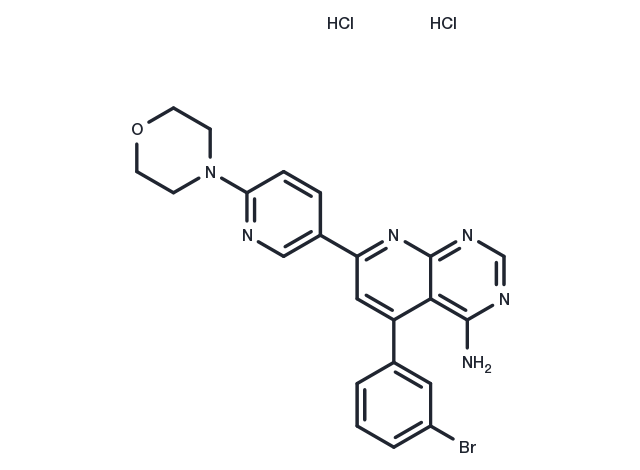Powder: -20°C for 3 years | In solvent: -80°C for 1 year
ABT-702 dihydrochloride is a potent adenosine kinase (AK) inhibitor.

| 説明 | ABT-702 dihydrochloride is a potent adenosine kinase (AK) inhibitor. |
| ターゲット&IC50 | Adenosine kinase:1.7nM |
| In vitro | ABT-702 is an orally effective adenosine kinase inhibitor that has several orders of magnitude selectivity over other sites of adenosine (ADO) interaction (A1, A2A, A3 receptors, ADO transporter, and ADO deaminase). ABT-702 is equipotent (IC50=1.5±0.3 nM) in inhibiting native human AK (placenta), two human recombinant isoforms (AKlong and AKshort), and AK from monkey, dog, rat, and mouse brain.ABT-702 also potently inhibits AK activity in intact cultured IMR-32 human neuroblastoma cells (IC50=51 nM), indicating that ABT-702 can penetrate the cell membrane and potently inhibit AK at its intracellular site. |
| In vivo | Rats received an intraperitoneal injection of DPCPX (3 mg/kg), ABT-702 (3 mg/kg), or a control substance 10 minutes before an intravenous dose of 2-18F-fluorodeoxy-D-glucose (FDG) (15.4±0.7 MBq per rat), followed by a 15-minute static PET scan. Images were standardized against an FDG PET template for rats, with standard uptake values (SUVs) calculated. Despite no change in overall brain FDG uptake due to drug treatment, significant regional reductions in metabolism, especially in the cerebellum, were observed in rats treated with DPCPX and ABT-702 compared to those receiving the control substance, indicating a modest effect of endogenous adenosine on FDG accumulation in a non-stimulated state. Body weight and blood glucose levels were consistent across all groups. Vehicle, ABT-702, and DPCPX treatment resulted in similar whole-brain PET SUVs (1.6±0.4, 1.6±0.6, and 1.8±0.6, respectively; F(2,9)=0.298, P=0.75), with statistical parametric mapping analysis identifying significant hypometabolism in the cerebellum and mesencephalon. ABT-702 markedly reduced acute thermal nociception in mice in a dose-dependent manner following both intraperitoneal (ED50=8 μmol/kg) and oral (ED50=65 μmol/kg) administration, as evidenced in the hot-plate test. This antinociceptive effect was further supported by dose-dependent results in the abdominal constriction assay (ED50=2 μmol/kg i.p.). |
| 動物実験 | Rats are fasted for 16 hours prior to use. At the beginning of the experiment, each rat is weighed, and then anesthetized using 5% isoflurane for induction and 2.5% for maintenance. A blood sample from tail vein is collected for a fasting blood glucose determination using a standard glucometer. Rats are then given an intraperitoneal (i.p.) injection of DPCPX (3 mg/kg, n=4), ABT-702 (3 mg/kg, n=4), or an equivalent volume of vehicle (15% dimethyl sulfoxide, 15% cremophor EL, 70% saline, n=4) to manipulate the effect of endogenous adenosine on neuronal activities. Ten minutes after i.p. injection, rats are administered FDG (15.4±0.7 MBq) in 0.3-0.5 mL saline by intravenous (i.v.) tail vein injection. Rats are allowed to recover from anesthesia after the FDG injection but are reanesthetized for 15-minute-static PET scan with the head in the center of the field of view. |
| 分子量 | 536.25 |
| 分子式 | C22H21BrCl2N6O |
| CAS No. | 1188890-28-9 |
Powder: -20°C for 3 years | In solvent: -80°C for 1 year
DMSO: 45 mg/mL (83.91 mM)
You can also refer to dose conversion for different animals. 詳細
bottom
Please see Inhibitor Handling Instructions for more frequently ask questions. Topics include: how to prepare stock solutions, how to store products, and cautions on cell-based assays & animal experiments, etc.
ABT-702 dihydrochloride 1188890-28-9 GPCR/G Protein Neuroscience Adenosine Receptor ABT702 dihydrochloride ADK ABT 702 Dihydrochloride Inhibitor inhibit ABT-702 Adenosine Kinase ABT 702 ABT 702 dihydrochloride ABT-702 Dihydrochloride ABT702 ABT702 Dihydrochloride inhibitor
